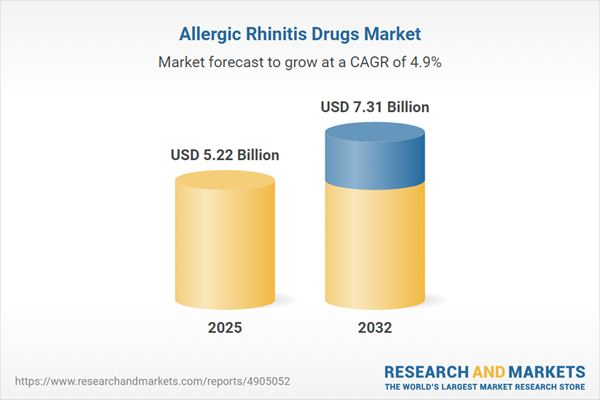Speak directly to the analyst to clarify any post sales queries you may have.
The allergic rhinitis drugs market is progressing through rapid technological advancements and regulatory shifts, prompting senior decision-makers to innovate and strengthen global growth strategies. As patient needs diversify and care paradigms evolve, organizations must optimize operational models and embrace integrated healthcare solutions to stay competitive.
Allergic Rhinitis Drugs Market Snapshot
This market is experiencing robust worldwide demand, driven by an increasing prevalence of allergic rhinitis and the expanded accessibility of advanced therapies. Innovation is advancing with the introduction of biologics and differentiated mechanisms of action, broadening options for clinicians and patients. Pharmaceutical organizations are integrating digital health technologies to improve medication delivery, streamline stakeholder interactions, and realize operational efficiencies. Across established and emerging regions, complex regulatory environments require organizations to evolve their commercial execution strategies. Ongoing technology investments and adoption of integrated care platforms play a critical role in enhancing scalability and reinforcing a strong position within both mature and growth markets.
Scope & Segmentation of the Allergic Rhinitis Drugs Market
This report provides senior executives with focused intelligence to inform international strategy and foster innovation across expanding portfolios of allergy therapies. Comprehensive segmentation guides market entry, product development, and risk management, enabling effective, evidence-based decisions in a global context.
- Distribution Channels: Including hospital pharmacies, retail outlets, specialty distributors, and online platforms, these facilitate targeted access and support flexible distribution frameworks that adapt to local demand and supply logistics.
- Patient Age Groups: Adult, pediatric, and geriatric segments each shape the requirements for age-appropriate formulations, impacting therapy pathways and risk considerations within the drug lifecycle.
- Dosage Forms: Options such as multi-use and single-use eye drops, injectables, oral solutions, nasal sprays, and tablets offer adaptability, supporting treatment delivery in hospitals, clinics, and alternative care sites.
- Routes of Administration: Nasal, ocular, oral, and parenteral delivery options align with patient-specific clinical needs and enhance adherence to evolving standards in allergy care.
- Drug Classes: Decongestants, intranasal corticosteroids, leukotriene receptor antagonists, mast cell stabilizers, and H1 antihistamines provide breadth in portfolios and facilitate lifecycle management and market differentiation.
- Regions Covered: Americas, Europe, Asia-Pacific, and Middle East & Africa, each with distinct regulatory conditions and market dynamics, require regionally adapted compliance and commercial strategies.
- Key Industry Players: Companies such as Johnson & Johnson, GlaxoSmithKline plc, Sanofi SA, Bayer AG, Merck & Co., Inc., Pfizer Inc., Novartis International AG, Boehringer Ingelheim, Teva Pharmaceutical Industries, and AstraZeneca plc drive innovation and influence strategic direction.
Key Takeaways for Senior Decision-Makers
- Biologic and targeted therapies are expanding research pipelines and prompting an increased need for advanced modalities in allergic rhinitis treatment across diverse care settings.
- Segmentation by patient age and delivery mode supports precise product development, ensuring tailored solutions align with country-specific care standards and varied patient requirements.
- Digital health technologies are transforming workflows by facilitating improved communication and supporting the efficient administration of allergy treatments for healthcare providers and patients alike.
- Strategic technology partnerships and resilient logistics practices enable organizations to mitigate supply chain uncertainties, while maintaining operational and regulatory adaptability.
- Comprehensive compliance frameworks are essential to maintaining stakeholder trust and effective risk management throughout the full product lifecycle, supporting organizational stability.
Tariff Impact: Navigating United States Tariff Adjustments
Changes to United States tariff policies require vigilant cost management and ongoing supplier evaluation for companies in the allergic rhinitis drugs sector. Organizations with cross-border supply chains are reassessing local production and renegotiating contracts to limit disruption. Proactive risk assessments and transparent collaboration with suppliers help ensure therapy access and continuity during evolving tariff and regulatory conditions.
Methodology & Data Sources
This analysis synthesizes data from peer-reviewed publications, regulatory documents, intellectual property filings, and direct interviews with industry leaders. Such a foundation equips executives with the strategic clarity necessary for managing allergic rhinitis therapy portfolios and guiding informed expansion decisions at an organizational level.
Why This Report Matters
- Equips leaders to monitor and adapt to changing trends within the allergic rhinitis drugs market, identifying new opportunities for sustainable growth.
- Supports effective planning and risk control across distribution, compliance, and global expansion, including region-specific regulatory adaptation.
- Strengthens operational frameworks, ensuring responsiveness to regulatory evolution and shifting provider expectations to maintain business agility.
Conclusion
Executives can leverage these insights to navigate market dynamics, align portfolios, and make confident strategic choices in the progressing allergic rhinitis drugs arena. Clear, data-driven decisions today support lasting, competitive business performance.
Additional Product Information:
- Purchase of this report includes 1 year online access with quarterly updates.
- This report can be updated on request. Please contact our Customer Experience team using the Ask a Question widget on our website.
Table of Contents
3. Executive Summary
4. Market Overview
7. Cumulative Impact of Artificial Intelligence 2025
Companies Mentioned
The companies profiled in this Allergic Rhinitis Drugs market report include:- Johnson & Johnson
- GlaxoSmithKline plc
- Sanofi SA
- Bayer AG
- Merck & Co., Inc.
- Pfizer Inc.
- Novartis International AG
- Boehringer Ingelheim International GmbH
- Teva Pharmaceutical Industries Ltd.
- AstraZeneca plc
Table Information
| Report Attribute | Details |
|---|---|
| No. of Pages | 199 |
| Published | October 2025 |
| Forecast Period | 2025 - 2032 |
| Estimated Market Value ( USD | $ 5.22 Billion |
| Forecasted Market Value ( USD | $ 7.31 Billion |
| Compound Annual Growth Rate | 4.9% |
| Regions Covered | Global |
| No. of Companies Mentioned | 11 |









